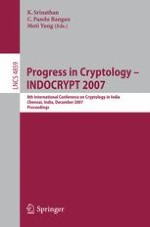2007 | Book
Progress in Cryptology – INDOCRYPT 2007
8th International Conference on Cryptology in India, Chennai, India, December 9-13, 2007. Proceedings
Editors: K. Srinathan, C. Pandu Rangan, Moti Yung
Publisher: Springer Berlin Heidelberg
Book Series : Lecture Notes in Computer Science
